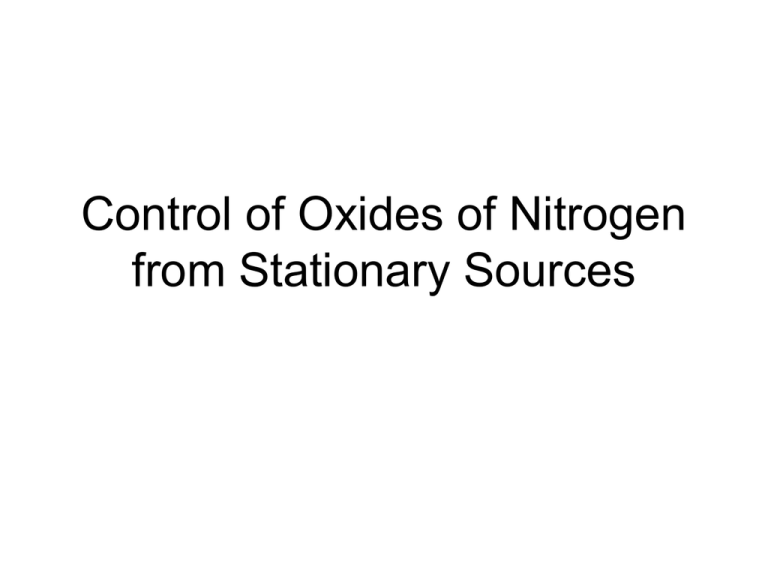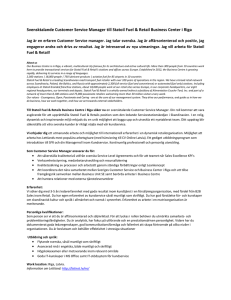Control of Oxides of Nitrogen from Stationary Sources
advertisement

Control of Oxides of Nitrogen from Stationary Sources Oxides of Nitrogen • The gaseous oxides of nitrogen include: – N2O:nitrous oxide – NO:nitric oxide (free radical) – N2O3: nitrogen trioxide – NO2:Nitrogen dioxide (free radical) – N2O5:nitrogen pentoxide An unstable form NO3 also exists. Only N2O,NO, and NO2 present in the atmosphere in significant concentrations NO and NO2 (NOx) • NO is a colorless gas with average ambient concentration of 0.5 ppm • No adverse health effect at this concentration but it is a precursor to the formation of NO2 and active compound in photochemical smog formation • NO2 is a reddish brown gas. A concentration of 1 ppm can be detected by the eye. Adverse health effect is primarily associated with the pulmonary problems.On an annual basis air ambient air level standart is 0.05 ppm (100 ug/m3) Sources and Concentrations of NOx • Over 90% of all man-made nitrogen oxides entering the atmosphere are from combustion sources • For the US, 50% is from mobile sources • For Turkey ambient NOx concentration is around xx • At an emission source the concentration of oxided of nitrogen is much higher than ambient values • For example the NOx concentration in the flue gas from the steam boiler of a power plant may reach 500 to 1000ppm • From such combustion processes the NOx is the exhaust stack gas would be 90% or more NO and the rest NO2 NOx Control • 1. Control over the reaction that produces the pollutant • 2. Remove NOx after it is formed NOx Formation Basic Chemistry,Thermodynamics and Kinetics of the Formation Reactions • There are two sources of N that contribute to the formation of oxides of nitrogen – 1. Fuel N (Coal and fuel oil composition, note that no N in natural gas)(Fuel NOx) – 2. Air N (78% of air is N)(Thermal NOx) Thermodynamics of Thermal NOx Formation • It is essential to understand the thermodynamics and kinetic of nitrogen-oxygen reactions, especially at high temperatures • NOx formation mechanism was first proposed by Zeldovich (1946): • N2+O⇋NO + N • N+O2⇋NO +O • N+OH⇋NO +H (1) (2) (3) Reaction 1 and 2 are the most important reactions in the model. Thermodynamics of Thermal NOx Formation • Let’s first consider only the NO and NO2 formation equilibrium reactions: • N2+O2⇋2NO • NO+1/2O2⇋NO2 2 (4) (5) ( PNO ) K P1 PN 2 PO2 K P2 PNO2 ( PNO )(PO2 )1/ 2 Equilibrium Constants: Temperature (K) 300 KP N2+O22NO 10-30 1.4(10)6 500 2.7(10)-18 1.3(10)2 1000 7.5(10)-9 1.2(10)-1 1500 1.1(10)-5 1.1(10)-2 2000 4.0(10)-4 3.5(10)-3 NO+1/2O2NO2 Predicted Equilibrium Concentrations Temperature (K) 300 Flue Gas (ppm) NO NO2 1.1(10)-10 3.3(10)-5 800 0.8 0.1 1400 250 0.9 1873 2000 1.8 Predicted Equilibrium Concentrations Flue 1. At flue gas exit T (420-590 K), expect to observe very low NOx Gas (ppm) (<1 ppm) and primarily NOx in the form NO2 NO2 Temperature (K) 300 NO 1.1(10)-10 3.3(10)-5 800 0.8 0.1 1400 250 1873 2000 1. At flame zone T (1850-3500 K), expect to observe very high 0.9 NOx (up to 10000 ppm) and primarily NOx in the form NO 1.8 Predicted Equilibrium Concentrations 1. At flue gas exit T (420-590 K), expect to observe very low NOx (<1 ppm) and primarily NOx in the form NO2 • At actual furnaces however typical flue gas consists of 300-1200 ppm NOx and mostly (90-95%) in NO form • So there must be other factors other than equilibrium to explain this: Kinetics of Nitric Oxide Formation in Combustion Process • The rate of NO formation is the major factor influencing NOx concentrations • Considering reactions 1 to 3, the rate expression can be written: • rNO= k+1[N2][O]-k-1[NO][N]+k+2[O2][N] -k-2[NO][O]+k+3[N][OH]-k-3[NO][H] • rN= k+1[N2][O]-k-1[NO][N]-k+2[O2][N] -k-2[NO][O]-k+3[N][OH]+k-3[NO][H] Rate Constants Rate constant k, m3/mol-s Reaction k+1 (1)N2+O⇋NO + N k-1 k+2 (2)N+O2⇋NO +O k-2 k+1=1.8(10)8e-38,370/T k-1= 3.8(10)7e-425/T k+2=1.8(10)4e-4680/T k-2= 3.8(10)3e-20820/T k+3=1.8(10)7e-450/T (3)N+OH⇋NO +H k-3 k-3= 3.8(10)8e-24560/T k+3 T is in degrees Kelvin Kinetics of Nitric Oxide Formation in Combustion Process • N atoms are much more reactive than NO, we can assume quasi steady state for N and an expression for [N]ss can be obtained: • [N]ss= k+1[N2][O]+k-2[NO][O]+k-3[NO][H]/ k-1[NO]+k+2[O2]+k+3[OH] And substituting this into rate equation for NO • rNO= k+1[N2][O]-k-2[NO][O]-k-3[NO][H]+( -k-1[NO]+k+2[O2]+k+3[OH])[N]ss Kinetics of Nitric Oxide Formation in Combustion Process The interesting thing about above rate equation is that the initial rate of formation of NO (when NO concentrations are small) is just equal to twice that of reaction 1. That is: • rNO= k+1[N2][O]-k-2[NO][O]-k-3[NO][H]+( -k-1[NO]+k+2[O2]+k+3[OH])[N]ss N2+O⇋NO + N (1) rNOinitial= 2k+1[N2][O] Example 16.2 • Given a HC flame at 1870 C where the mole fractions of N2 gas and O atoms are 0.75 and 9.5(10)-4 respectively, • a) calculate the initial rate of NO formation (in mole(m3-s) • b) if this rate holds constant for 0.03 seconds, calculate the concentration in ppm of NO in the gases leaving the flame zone Solution • a) at T = 1870 C = 2143 K, k+1=1.8(10)8e-38,370/2143=3.015 m3/mol-s Assuming P= 1atm, the molar density of the gases: 1atm M P / RT 8.206(10) 5 m3 atm mol K 2143K 5.686m ol/ m3 [N2]=0.75x5.686=4.26 mol/m3 [O]=9.5(19)-4x5.686=0.0054 mol/m3 rNOinitial= 2k+1[N2][O]=2(3.015)(4.26)(0.0054) =0.1388 mol/m3-s Solution • b) If this inital rate holds for 0.03 seconds then [NO]=0.1388(0.03)=4.16(10)-3 mol/m3 4.16(10) 3 [ NO] (10) 6 732ppm 5.686 Research on NOx Formation • Experimental results in various studies showed that NO concentrations in the flame zone are significantly higher than could have been formed by the Zeldovich mechanism • This may be due to “prompt” NO formation • Prompt NO: NO formed in the first five milliseconds (40-100 ppm) Research on NOx Formation • MacKinnon worked with heated N2,O2, Ar samples • NO concentrations increased rapidly with time up to about 4-5 seconds, after no further increases observed T (C ) NO conc. <1600 <200 ppm >1800 =1950 Several thousands 12,000 1990 Peak value >2000 decreases Research on NOx Formation • MacKinnon developed a model predicts the NO concentration (in ppm) as a function of temperature (in K), N and O concentrations, and time (in s) CNO 5.2(10) [exp 72,300/ T ] yN2 y t 17 1/ 2 O2 NOx Formation from Fuel Nitrogen • When a fuel contains organically bound N, the contribution of the fuel bound N to the total NOx production is significant Example 16.3 Strategies for Combustion Modification fuel fuel Equivalentratio() : / air air Stoichiometric • Reduce peak temperatures of the flame zone • Reduce gas residence time in the flame zone 2015/4/13 Aerosol & Particulate Research Lab 25 Modification of Operating Conditions • Off-Stoichiometric Combustion/Staged combustion: combusting the fuel in two or more steps. Fuel rich then fuel lean. • Flue gas recirculation: reroute some of the flue gas back to the furnace; lower O2 and allow NOx to proceed the “frozen” reactions • Water injection: reduce http://en.wikipedia.org/wiki/Staged_combustion_cycle_(roc ket) flame temperature; energy 2015/4/13 Aerosol & Particulate Research 26 penalty Lab • Gas reburning: injection of natural gas into the boiler above the main burner to create a fuel-rich reburn zone; hydrocarbon radicals react with NOx to reduce NOx to N2. 2015/4/13 Aerosol & Particulate Research 27 http://www.lanl.gov/projects/cctc/factsheets/eerco/gasreburndemo.html Lab • Low-NOx burner: inhibit NOx formation by controlling the mixing of fuel and air; lean excess air and off-stoichiometric combustion 2015/4/13 Aerosol & Particulate Research Lab 28 Case: Paşabahçe Glass Production Flue Gas Treatment • Selective Catalytic Reduction (SCR) or V2 O5 supported catalyst 4 NO 4 NH 3 O2 TiO 2 4 N 2 6 H 2O or V2O5 supported catalyst 2 NO2 4 NH 3 O2 TiO 2 3N 2 6 H 2O Temperature ~ 300 - 400 oC Q: Why is it called “selective”? Also good for Hg emission control!!! But it creates SO3. • Selective Noncatalytic Reduction (SNR) 4 NH 3 4 NO O2 4 N 2 6 H 2O Temperature ~ 800 - 1000 oC 4 NH 3 5O2 4 NO 6 H 2O Above 1000 oC 2015/4/13 Aerosol & Particulate Research Lab 31 SCR • • • • • Removal efficiency is over 90% Expenses from use of catalyst High operation and capital cost Large area requirement Requires temperature control for optiumum reduction SNCR • No catalyst cost • High temperatures (850-1100) • Low removal efficiency ( %30-%66 less than SCR) Other Control Methods • Absorption • Adsorption • Biological Biological Control Technologies Under aerobic conditions, nitrification and chemical oxidation leads to NOx oxidation to nitrate. İlk denemelerde, yüksek O2 konsantrasyonlu aerobik şartlarda (>%17 Oksijen) NO giderimi toluenle muamele edilmiş silika pelet dolgulu bir biyofiltrede %97 mertebesinde başarılmıştır Biological Control Technologies Anoksik koşullarda ise NOx denitrifikasyon prosesi yüksek bir verimle azot gazına indirgenmektedir. Toprak kompostu içeren laboratuar ölçekli bir biyofiltre çalışmasında NO2 için %100’e yaklaşan bir giderim verimi elde edilmiştir. (Okuno et. al, 2000). Tüm bunlar BiyoDeNox teknolojilerinin NOx kontrolü için gelecekte de artan oranlarda kullanılacağını göstermektedir. Biological Control Technologies Avantajlar Biyofiltreler Biyo-yıkama Dezavantajlar Geleneksel dizaynı için geniş alan ihtiyacı vardır Kurulum maliyeti düşüktür. İşletim maliyetleri genellikle Yatakta pH ayarı veya besin eklemek düşüktür. için iç sıvı akışı sürekliliği yoktur Belirli bileşikler için yüksek Tepesinin olmaması temsili numune DREs oluşur alımını zorlaştırır Yatak değişimi 2- 6 hafta sürebilir Arıtım öncesi gazı nemlendirmek gerekli değildir Kurulumu oldukça pahalıdır Aşırı biyokütle büyümesi tıkanmalara neden olabilir Diğer biyoreaktörlere göre daha az ayakizi vardır pH kontrolü ve besin besleme İşletme maliyetleri diğer biyoreaktör otomatikleştirilebilir proseslerinden fazladır Asit üreten tesislerin atık Pahalı ve kompleks besleme ve nötralize gazları için idealdir etme sistemleri gereksinimi vardır Partikül madde içeren Toksik ve tehlikeli bileşiklerin emisyonların arıtımına envanterinin tutulması ve uygundur uzaklaştırılması gerekir Biological Control Technologies BioDeNOx Process BioDeNOx Process • First nitrosyl complex was formed by the reactions 1 and 2: • NO (g) NO (aq) (1) • NO (aq) + Fe(II)EDTA2- > Fe(II)EDTA − NO2(2) BioDeNOx Process • To be able to regenarate the absorption liquid, formed Fe(III)EDTA- needs to be reduced to Fe(II)EDTA2- by the m/o • Regeneration of Fe(II)EDTA2- is essential for the system NO removal performance: • 12 Fe(III)EDTA- + C2H5OH + 3 H2O 12 Fe(II)EDTA 2- + 2 CO2 + 12 H+ Jet-Loop Biyoreaktör • JetLoop reaktörlerde sistem içinde draft tüpüne püskürtülen gaz reaktörü terk etmeden önce draft tüpün içerisinde birkaç kez devir yapmaktadır. • Devir sayısı ve jet akımından kaynaklanan daha küçük çaplı gaz oluşumu NO gazının ortama bir kelat ilave etmeksizin daha fazla çözünmesini sağlamaktadır. İTÜ XIII. Endüstriyel Kirlenme Kontrolü Sempozyumu Pilot Tesis • Toplam hacim 20 L, Çamur yaşı 50 gün, 1. Su girişi 2. Hava/gaz girişi 3. Hava/gaz çıkışı 4. JetLoop biyoreaktör 5. Su boşaltma vanası 6. Soğutucu 7. Su debimetresi 8. ÇO, Redox, pH, Sıcaklık sensörleri haznesi 9. Pompa 10. Besleme girişi 11. MBR sistemi, V: vana) İTÜ XIII. Endüstriyel Kirlenme Kontrolü Sempozyumu Pilot Tesis İTÜ XIII. Endüstriyel Kirlenme Kontrolü Sempozyumu Pilot Tesis İşletme Sonuçları MLSS QGD Besleme ORP Deney Q /Q Gaz GD (mg/L) (m3/sa) Şekli (mV) Giriş Çıkış Verim NO NO (%) (ppm) (ppm) 1 3000 1.0 0.12 Sürekli -485 550 427 23 3* 2640 1.0 0.12 Sürekli -476 1100 820 25 2 3000 1.8 0.07 Sürekli -488 550 175 70 4* 2400 1.8 0.07 Sürekli -475 1100 413 65 İTÜ XIII. Endüstriyel Kirlenme Kontrolü Sempozyumu
